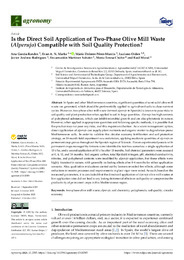Título :
Is the Direct Soil Application of Two-Phase Olive MillWaste (Alperujo) Compatible with Soil Quality Protection? |
Autor :
Pérez Murcia, Mª Dolores 
Netherton Marks, Evan Alexander
García Rández, Ana
Orden, Luciano 
Andreu Rodríguez, Fco. Javier 
Martínez Sabater, Encarnación 
Cháfer, Teresa
Moral, Raúl |
Editor :
MDPI |
Departamento:
Departamentos de la UMH::Agroquímica y Medio Ambiente |
Fecha de publicación:
2023-10 |
URI :
https://hdl.handle.net/11000/34228 |
Resumen :
In Spain and other Mediterranean countries, significant quantities of semi-solid olive mill
waste are generated, which should be preferentially applied to agricultural soils to close nutrient
cycles. However, two-phase olive mill waste (termed alperujo in Spanish) is known to pose risks to
soil quality and plant production when applied to soil in large quantities. Alperujo has high contents
of polyphenol substances, which can inhibit microbial growth and are also phytotoxic in nature.
However, when applied in appropriate quantities and following specific methods, it is possible that
the practice may not pose any risks, and this requires evaluation. As a waste management option,
direct application of alperujo can supply plant nutrients and organic matter to degradation-prone
Mediterranean soils. In order to validate this circular economy fertilization and soil protection
strategy, an 18-month field experiment was undertaken, applying moderate quantities of alperujo on
permanent crop groves throughout the Spanish region of Valencia. Eleven experimental parcels with
permanent crops managed by farmers were identified to test two scenarios: a single application of
10 t/ha, and a second application of 10 t/ha after 10 months. Soil chemical parameters were assessed
at 0, 6, 10, and 18 months. Soil organic carbon, total Kjeldahl nitrogen, pH, electrical conductivity,
nitrates, and polyphenol contents were modified by alperujo application, but these effects were
highly transient in nature, with generally no lasting effects after 4–6 months for either application
scenario. Also, qualitative evaluations carried out by farmers revealed few effects, although some
reductions in erosive processes and improvements in plant vigor were noted. As such, based on the
measured parameters, it is concluded that the direct soil application of alperujo olive mill wastes at
low application rates did not lead to any lasting detrimental effects on soil quality or compromise the
productivity of permanent crops in this Mediterranean region.
|
Palabras clave/Materias:
two-phase olive mill waste
alperujo
soil chemistry
polyphenols
soil quality
circular economy |
Tipo de documento :
info:eu-repo/semantics/article |
Derechos de acceso:
info:eu-repo/semantics/openAccess
Attribution-NonCommercial-NoDerivatives 4.0 Internacional |
DOI :
https://doi.org/10.3390/agronomy13102585 |
Publicado en:
Agronomy 2023, 13, 2585 |
Aparece en las colecciones:
Artículos Agroquímica y Medio Ambiente
|
 La licencia se describe como: Atribución-NonComercial-NoDerivada 4.0 Internacional.
La licencia se describe como: Atribución-NonComercial-NoDerivada 4.0 Internacional.
.png)
